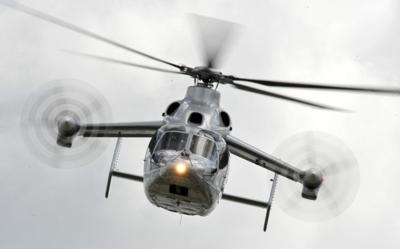Seven-Week Demonstration Circuit Shows Off Proof-Of-Concept Aircraft
Eurocopter has completed its seven-week X3 demonstration tour in the United States, enabling a full range of civil and military operators to witness – and experience – the flight characteristics of the high-speed, long-range hybrid helicopter. The X3 returned this week to its home base at the Istres Flight Test Center in southern France, where it arrived aboard a chartered cargo jetliner that airlifted the aircraft from Virginia in the U.S.

During its U.S. tour, the X3 made appearances in four states from Texas to Virginia – logging more than 55 hours performed by the Eurocopter test crew, along with opportunities for 47 guest pilots to take the controls for some first-hand experience with the aircraft’s flight qualities, maneuverability, and acceleration/deceleration capabilities.
Among the X3’s flight characteristics discussed by these pilots were its stability and low vibration level, the acceleration and deceleration described as "impressive," the capability to make steep descents while controlling the speed, the aircraft’s capacity to hover nose-down or nose-up, and its ability to be flown throughout the entire flight envelope with the autopilot off. “We are highly encouraged by the overwhelmingly positive feedback from potential future U.S. civil and military users, which once again confirms the need for such a new approach that combines game-changing performance with highly cost-effective economics,” said Eurocopter President and CEO Lutz Bertling. “We are convinced it can significantly enhance operations across multiple sectors, as underscored by the feedback we received at every stopover in the United States.”
The U.S. visit marked the X3’s first-ever major tour, along with its initial appearance outside of Europe. Underscoring the maturity of Eurocopter’s hybrid helicopter concept, the aircraft performed its entire tour as planned, from a special kick-off event and a week of demonstrations at the Grand Prairie, Texas headquarters of Eurocopter’s American Eurocopter U.S. subsidiary, to scheduled presentations at the Redstone Arsenal Army Airfield in Huntsville, Alabama; Simmons Army Airfield at Fort Bragg near Fayetteville, North Carolina; Manassas Regional Airport in Manassas, Virginia; Davison Army Airfield at Fort Belvoir, Virginia;, and the Pentagon, adjacent to Washington, D.C.

Flying presentations throughout the X3 tour were performed by Eurocopter experimental test pilot Hervé Jammayrac, accompanied by flight test engineers Daniel Semioli and Dominique Fournier, along with project and technical team members. Guest pilots provided with opportunities to fly the X3 included aviators from U.S. military services, law enforcement agencies, medical airlift service providers, offshore operators, and the aircraft services sector.
The X3’s dynamic results from its unique configuration, which uses a pair of turboshaft engines to power both a five-blade main rotor system and two propellers installed on short-span fixed wings. To date, the hybrid aircraft has demonstrated a maximum speed of 232 knots at 80 percent power, as well as a rate of climb of 5,500 feet per minute. It also has very low vibration levels without the need for any passive or active anti-vibration systems.
Eurocopter advanced the X3 hybrid configuration from concept to first flight in 2.5 years. After going airborne for the first time at the Istres Flight Test Center in September 2010, the aircraft’s flight envelope was quickly opened – reaching the initial speed objective of 180 kts. (333 km/hr.) in level flight only weeks later. Flights resumed in March 2011 after a planned validation of the gearboxes for operations at full power, with the X3 easily surpassing its original speed target of sustained cruise speeds of 220 kts.
(Images provided by Eurocopter)
 ANN's Daily Aero-Term (04.24.24): Runway Lead-in Light System
ANN's Daily Aero-Term (04.24.24): Runway Lead-in Light System ANN's Daily Aero-Linx (04.24.24)
ANN's Daily Aero-Linx (04.24.24) Aero-FAQ: Dave Juwel's Aviation Marketing Stories -- ITBOA BNITBOB
Aero-FAQ: Dave Juwel's Aviation Marketing Stories -- ITBOA BNITBOB Classic Aero-TV: Best Seat in The House -- 'Inside' The AeroShell Aerobatic Team
Classic Aero-TV: Best Seat in The House -- 'Inside' The AeroShell Aerobatic Team Airborne Affordable Flyers 04.18.24: CarbonCub UL, Fisher, Affordable Flyer Expo
Airborne Affordable Flyers 04.18.24: CarbonCub UL, Fisher, Affordable Flyer Expo




